| |
 
EAST MEON AND
THE BISHOPS OF WINCHESTER
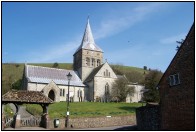 |
|
East Meon is one
of the most attractive villages in the
south of England, with the river flowing
along the high street and the church
seemingly built into the hillside. It
sits at the foot of the Downs, with
Butser to the south-east and the mighty
Iron Age hill fort of Old Winchester
Hill, now a nature reserve, to the
south-west. There were Roman Villas
nearby, and in Saxon times the manor was
the property of Alfred the Great.
But East Meon as we know it today is
inextricably associated with the history
of Winchester Cathedral. |
William the Conqueror
quickly installed his friend, Walkelin as Bishop
in place of the Saxon, Stigand, and he
immediately began to rebuild the cathedral in the
solid, heavy Norman style that can still be seen
in the transepts. At the same time he rebuilt the
existing church at East Meon and crowning it with
a mighty tower.
| Another Bishop of
Winchester during the Norman period was
Henry of Blois, the brother of King
Stephen. As Chancellor of England he was
one of the most important men in the
realm, and he was responsible for
building the Bishop’s Palace at
Bishop’s Waltham, the Hospital of
St. Cross and Farnham Castle. He also had a passion for
beautifying his churches, and East
Meon’s greatest treasure dates from
his time.
Four Hampshire churches possess fonts
made of black marble, brought from
Tournai in Belgium in about 1150, and
other than the one in the Cathedral, East
Meon’s is by far the best. It is
vividly carved with the story of Adam and
Eve, both sporting magnificent
fig-leaves.
|
|
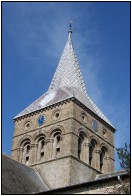 |
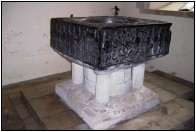 |
|
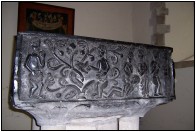 |
|
After the
Metropolitan Sees of Canterbury and York,
Winchester ranked first among all the
English bishoprics, and men like William
of Wykeham, Bishop of Winchester between
1367 and 1404, held immense power and
influence. He was twice Lord Chancellor,
and founded both Winchester College and
New College, Oxford, as well as
overseeing the rebuilding the nave of the
Cathedral. |
The Bishops of
Winchester had from time immemorial held the
manor of East Meon, and it was during
Wykeham’s time that the Court House was
built, just south east of the church. It became
an administrative centre and home to a number of
monks who played host to the Bishop when he held
his manorial court there. The building remains
just across the road from the church to this day,
although by the beginning of the 19th century it
housed farm workers and the great hall was a cow
byre. The whole building was restored in 1927.
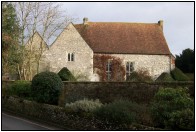 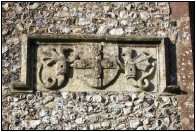 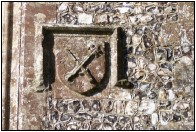
The last
Bishop of Winchester to have a great impact on
East Meon was Thomas Langton at the end of the
fifteenth century, who, with Prior Hinton, in a
rare example of co-operation between one of the
bishops and the prior, oversaw the remodelling of
the east end of the church. Their Coats of Arms,
carved in stone, can be seen to this day in the
east wall. Langton was elected Archbishop of
Canterbury in 1501, but died before he could be
enthroned.
The village was later involved in the Civil War,
Cromwell’s army camping close by immediately
before the decisive battle of Cheriton
In 1986. the 900th anniversary of the Domesday
Book, East Meon was chosen as the Domesday
Village, with a model in the Great Hall of
Winchester Castle showing the village as it then
was. The model is now in the Musée de la
Tapisserie in Bayeux, alongside the tapestry that
records how England became part of Normandy,
whose Duke William was indirectly responsible for
the East Meon we know today.
Tom Muckley, August 2006
This article was originally
published by the
Petersfield Post
tommuckley.co.uk
|
|








